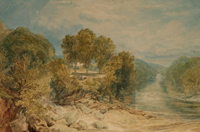Ruskin's Catalogue of Examples (1870)
Ruskin's first catalogue with notes containing his plans for the Standard, Reference and Educational series.

-
 101. Rameses III and suppliants.
101. Rameses III and suppliants.
-
 102.
Chariot of Rameses III.
102.
Chariot of Rameses III.
-
 103.
Encampment of Rameses III.
Rosellini, Tavole, tom. i. pl. 83.See the text, tom. iv. p. 119, &c.
103.
Encampment of Rameses III.
Rosellini, Tavole, tom. i. pl. 83.See the text, tom. iv. p. 119, &c.
-
 104. Menepthah II adoring Phre.
Rosellini, Tavole,
tom. i. pl. 118.
Text, tom. iv. p. 305.
104. Menepthah II adoring Phre.
Rosellini, Tavole,
tom. i. pl. 118.
Text, tom. iv. p. 305.
-
 105. Rameses IV adoring Isis and Osiris.
Rosellini,
Tavole, tom. i. pl. 145.
Text, tom. v. p.104.
105. Rameses IV adoring Isis and Osiris.
Rosellini,
Tavole, tom. i. pl. 145.
Text, tom. v. p.104.
These plates, of which 101 and 102 are portions of 103 enlarged, represent, accurately enough for general intelligibleness, the manner of fine Egyptian art in coloured intaglio. And the study of the development of this form of decoration will introduce us to every condition of good Gothic sculpture.
Observe, respecting these plates of Rosellini, that the colours are in great part conjecturally restored; slight traces of the original pigments, and those changed by time, being interpreted often too arbitrarily: and that the beauty or vulgarity of any given colour, much more that of its harmony with others, is determined by delicacies of hue which no restorer can be secure of obtaining, and few attempt to obtain.
The student, therefore, can only depend on these plates for the disposition of the colours, not for their qualities.
- 141. Windows from Chalons-sur-Marne.
-
 151.
Porch of Church of San Zenone, Verona.
151.
Porch of Church of San Zenone, Verona.
-
 155.
Porches of Chartres Cathedral, west front.
155.
Porches of Chartres Cathedral, west front.
-
 160.
Flanking pier of porch, Rheims Cathedral, west front.
160.
Flanking pier of porch, Rheims Cathedral, west front.
I have placed these four examples at once where they are to remain, in order to mark clearly the character of the architecture, whatever its date or country, which depends chiefly for its effect on the sculpture or colouring of surfaces, as opposed to that which depends on construction or proportion of forms. Both these schools have their own peculiar powers; and neither of them are to be praised, or blamed, for the principle they maintain, but only for their wise or unwise manner of maintaining it.
The buildings in which the walls are treated as pages of manuscript are good when what is written upon them is rational, and bad when it is foolish; and, similarly, buildings whose structure is their principal merit, are good when they are strong and delicately adjusted, and bad when they are weak and ungraceful.




